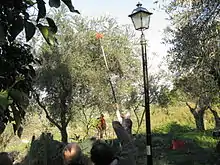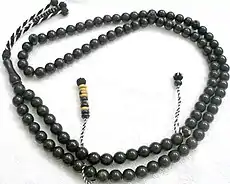Tweeza
| Part of a series on Islam Sufism |
|---|
|
|
Tweeza (Arabic: تويزة), also Touiza or Tiwizi, is the term used in Algeria to designate the cooperation in a sufi and cultural heritage in which a group from the tariqa or zawiya in a community or village gathers and cooperates in order to contribute to the achievement of charitable work, help the needy or the poor, build a house for a person or a mosque, clean a cemetery or village or mosque, or harvest wheat fields and olive trees.[1][2]
Presentation
The Tweeza is reflected in the village societies revolving around the Sufi zawiyas by voluntary action and by cleaning, weeding, collecting waste and other rubbish as well as the planting of fruit and ornamental trees.[3][4]
This collective and voluntary activity of the murids is thus initiated to rehabilitate scrub cemeteries, which represents a gesture of awareness which implies a surge of solidarity from the citizens of the entire village.[5][6]
In addition to the Sheikh of the Zawiya of the region who oversees the activity of the Tweeza through his Barakah, it is also the Thadjmaath of each village who coordinates the associative logistics in collaboration with local elected officials and Imams of mosques, and even personalities acquired to the environmental and social cause of the community.[7][8]
This altruistic participation results in the donation of quality shrubs from botanical nurseries, especially during the rainy season despite the unfavorable climatic conditions.[9]
This action maintains the concept of Tweeza and rehabilitates it in the form of a voluntary service which was once practiced everywhere in the rural and village world, and which must be protected and preserved from the tendency to disappear over time due to of modernity and urbanization.[10][11]
The Tweeza supposes the union or the conjugation of the efforts of the "Thadjmaath" to carry out works of common interest such as the plowing-sowing campaigns, the construction of mosques, zawiyas and medersas.[12]
It is also a form of mutual aid to support the underprivileged groups when it comes to building homes by reducing and mitigating the resulting financial charges.[13]
This is how the Tweeza consolidates the bonds of friendship, fraternity and solidarity between rural citizens in the popular mountain neighborhoods and cities and in the suburbs and outskirts of urbanized cities.[14][15]
Harvesting olives
During the end of autumn and the beginning of winter, all the women of the villages meet with their children to collect together and in turn all the olives, a kind of Tweeza, all in a good-natured atmosphere by reciting Achewiq songs in chorus.[16][17]
As every year, the inhabitants of these steep regions celebrate the olive picking by the Tweeza and festivals that last all the month of December and extend until January to welcome the Berber New Year called Yennayer.[18][7]
Women and men are mobilized to make these festivities a success, which reinforces the spirit of solidarity between the villagers, especially at the end of the day around a large dish of couscous.[19]
For guests from outside the village, honey and grape pancakes are offered in these olive-growing regions where the Tweeza accompanies the picking of olives in a ceremonial climate, where it is the village Amin who gives the signal for galling.[20]
The Tweeza troop then moves, from olive grove to olive grove during each day, and in the evening, in each dechra, it is the night party with meals and sweets embellished by songs in honor of the tree. of the blessed olive tree.[21][22]
See also
References
- "Méchéria: Réhabiliter la "touiza"". Djazairess.
- "Retour en force de la touiza". Djazairess.
- "La campagne de la récolte des olives entamée". Djazairess.
- "La touiza, un réflexe qui n'a plus cours". Djazairess.
- "L'olivier, un arbre de civilisation et de paix". Djazairess.
- "Une Touiza au Ghoufi fête la reconnaissance de Yennar". Djazairess.
- "Touiza pour la construction d'une école". Djazairess.
- "Touiza à Merj Eddib". Djazairess.
- "Après un incendie enregistré au début de l'été : Une touiza pour le Ghoufi". Djazairess.
- "Pourquoi pas une " Touiza " ?". Djazairess.
- "Khenchela : le village de Tibelaâyne vit au rythme de la Touiza". Djazairess.
- "Une "Touiza" redonne vie au village Béni Ferah". Djazairess.
- "Jijel : une "Touiza" redonne vie au village Béni Ferah". Djazairess.
- "Tiwizi en Kabylie : Les chants des cueilleuses d'olives, un patrimoine à sauvegarder |". lecourrier-dalgerie.com.
- "La touiza, un exemple à suivre". Djazairess.
- "Tiwizi en Kabylie : les chants des cueilleuses d'olives, un patrimoine à sauvegarder". Djazairess.
- "Fête de l'olivier, l'arbre de paix". Djazairess.
- "Laghouat : La "Touiza", une tradition séculaire qui tombe peu à peu dans l'oubli". Djazairess.
- "La "Touiza" tombe dans l'oubli". Djazairess.
- "LAGHOUAT Touiza, une tradition qui tombe dans l'oubli". Djazairess.
- Tiwizi en Kabylie : les chants des cueilleuses d’olives, un patrimoine à sauvegarder
- "La touiza, un exemple à suivre". Djazairess.

